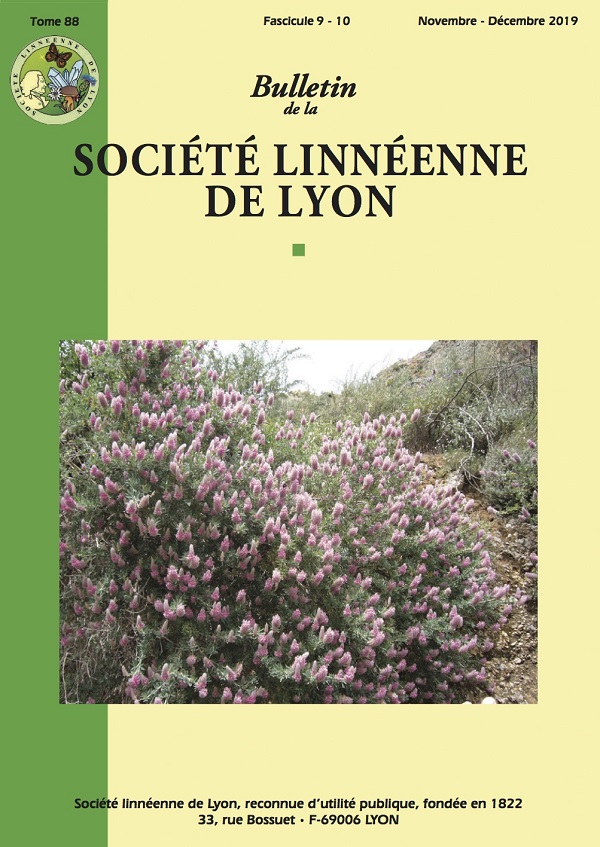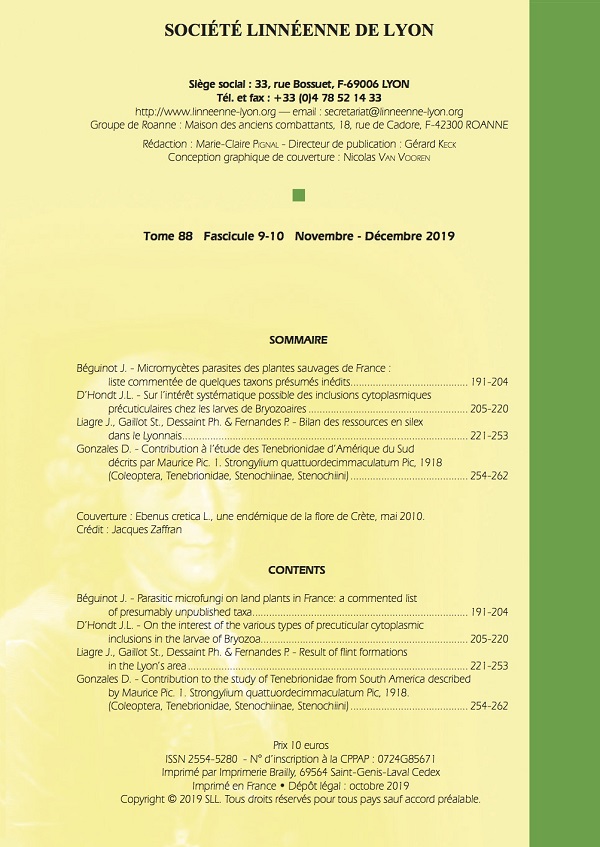Bulletin de la Société linnéenne de Lyon, 2019, tome 88, fascicule 9-10
par
popularité : 5%
Bulletin de la Société linnéenne de Lyon, 2019, tome 88, fascicule 9-10

Couverture : Ebenus cretica L., une endémique de la flore de Crète, mai 2010. Crédit : Jacques Zaffran

BÉGUINOT Jean
Mycromycètes parasites des plantes sauvages de France : liste commentée de quelques taxons présumés inédits ...... 191-204
Résumé. – A la suite d’un inventaire de plus de 800 micromycètes parasites de plantes réalisé principalement dans le Centre de la France, 47 taxons se sont révélés ne pas avoir de correspondance satisfaisante avec les espèces déjà décrites dans les manuels habituels consacrés à ce sujet. En tant que tels, ces taxons, apparemment encore inédits, peuvent constituer un matériel intéressant, pour lequel les descriptions critiques correspondantes sont précisées.
Mots clés. – Fungi imperfecti, Deutéromycètes, nouveautés.
Parasitic microfungi on land plants in France : a commented list of presumably unpublished taxa
Abstract. – As part of an inventory of more than 800 parasitic Microfungi on land plants from the centre of France, 47 taxa reveal having no satisfactory correspondence with already described species in the usual textbooks devoted to this subject. As such, these seemingly yet unpublished taxa may constitute material of interest, for which critically commented descriptions are provided.
Key words. – Fungi imperfecti, Deuteromycota, new observations.
ANALYSE D’OUVRAGE par BERTHET Paul ...... 204
Noël ARPIN. Plantes et fleurs du Dauphiné (Drôme, Isère, Hautes-Alpes) et de la Savoie, 2019. 3 vol., 150 €. Commande : s’adresser à Noël Arpin, 2 place de l’Hôtel de Ville, 26530 Le Grand-Serre,
04 75 68 98 10 – noelarpin@wanadoo.fr
D’HONDT Jean-Loup
Sur l’intérêt systématique possible des inclusions cytoplasmiques précuticulaires chez les larves de Bryozoaires ...... 205-220
Résumé – Essai d’interprétation des différents types d’inclusions cytoplasmiques précuticulaires présents dans les tissus exosquelettogènes de différents modèles de larves de Bryozoaires.
Mots-clés – Bryozoaires, larves, cytologie, inclusions précuticulaires.
On the interest of the various types of precuticular cytoplasmic inclusions in the larvae of Bryozoa
Abstract – An attempt of interpretation of the various types of precutilar cytoplsmic inclusions present in the tissues from which the exsoskleleton is issued in some models of Bryozoa larvae.
Key-words – Bryozoans, larvae, cytology, precuticular inclusions.
LIAGRE Jérémie, GAILLOT Stéphane, DESSAINT Philippe, FERNANDES Paul
Bilan des ressources en silex dans le Lyonnais ...... 221-253
Résumé. – Le Programme Collectif de Recherche « Réseau de lithothèques en Rhône-Alpes » (coordination P. Fernandes) a été créé en 2006. Un de ses objectifs principaux est le recensement des matières premières siliceuses présentes sur toute la région AuvergneRhône-Alpes. Depuis 2009, le Service Archéologique de la Ville de Lyon, par une participation constante aux rapports d’activités du PCR, s’est proposé de constituer une base de données dans une zone géographique où les informations sur les matières premières sont rares. Cette démarche a permis d’établir une lithothèque représentative du Lyonnais. Ce territoire est situé à la confluence du Rhône et de la Saône, au cœur du couloir rhodanien et dans une zone-carrefour central naturel du sud-est de la France. Lyon et ses abords représentent une zone de transit et d’occupation importante durant les périodes pré- et protohistoriques. Cette base de données « silex » a comme finalité une analyse spatiale des zones d’accessibilité actuelles des matériaux exploités ou importés sur les sites archéologiques. Plusieurs actions de terrain (prospections et observations géomorphologiques) ont donc été organisées conjointement et selon les principaux axes suivants : évaluer le potentiel des variations pétrographiques siliceuses au niveau local, décrire sous forme de fiches les différents faciès de silex et, enfin, établir des cartes géoréférencées de localisation des gîtes.
Mots-clés. – Territoire lyonnais, formation de silex, inventaire, gisements, cartographie, SIG, caractérisation, pétrographie.
Result of flint formations in the Lyon’s area
Abstract. – The collective research program “lithological collections network in the Rhône-Alpes region, Fr” is coordinated by P. Fernandes, and started in 2006. One of its main goals is the inventory of siliceous raw material geological sources across the Rhône-Alpes Auvergne region. The archaeological department of the city of Lyon (SAVL) contributes in this research program since 2009, and built a lithological database of the Lyon territory, where few data were previously available. The Lyon area is a natural crossroad of the Rhodanian corridor, at the confluence of the Rhône River and the Saône River. This region was an important settlement and transit area during the pre- and proto-historical times. The flint database aims at providing the basis for spatial analysis, such as the study of the accessibility of the extraction sites, exploitation sites, and archaeological sites. Several geomorphological field prospections have been carried out in order to approach the following topics : evaluating the siliceous petrographic variations at a local scale, producing and filling forms describing in details the various flint facieses, and finally establishing maps locating flint deposits.
Key-words. – Lyon territory, flint formations, inventory, flint deposits, mapping, GIS, petrography, geological characterization. 1
GONZALES David
Contribution à l’étude des Tenebrionidae d’Amérique du Sud décrits par Maurice Pic.
1. Strongylium quattuordecimmaculatum Pic, 1918 (Coleoptera, Tenebrionidae, Stenochiinae, Stenochiini) ...... 254-262
Résumé. – La description de l’espèce Strongylium quattuordecimmaculatum Pic, 1918 est complétée et illustrée d’après le type. Une erreur de localisation de l’espèce est corrigée et une mise en synonymie avec Strongylium maculicolle Champion, 1887 est établie.
Mots-clés. – Tenebrionidae, Strongylium, redescription, nouvelle synonymie, Bolivie, Panama.
Contribution to the study of Tenebrionidae from South America described by Maurice Pic. 1. Strongylium quattuordecimmaculatum Pic, 1918. (Coleoptera, Tenebrionidae, Stenochiinae, Stenochiini)
Abstract. – The description of the species Strongylium quattuordecimmaculatum Pic, 1918 is completed and illustrated according to the type. A location error of the species is corrected and a synonymy with Strongylium maculicolle Champion, 1887 is established.
Key-words. – Tenebrionidae, darkling beetle, Strongylium, description, new synonymy, Bolivia, Panama.
PARTIE ADMINISTRATIVE
ORDRES DU JOUR POUR NOVEMBRE-DÉCEMBRE 2019 ...... XVII-XX
TABLE DES MATIÈRES
Année 2019 - Tome 88 ...... 263-264
